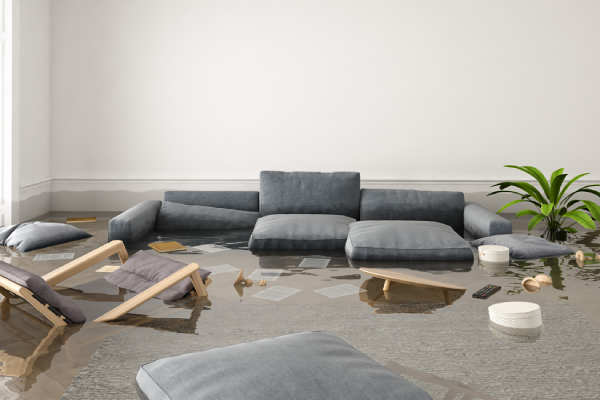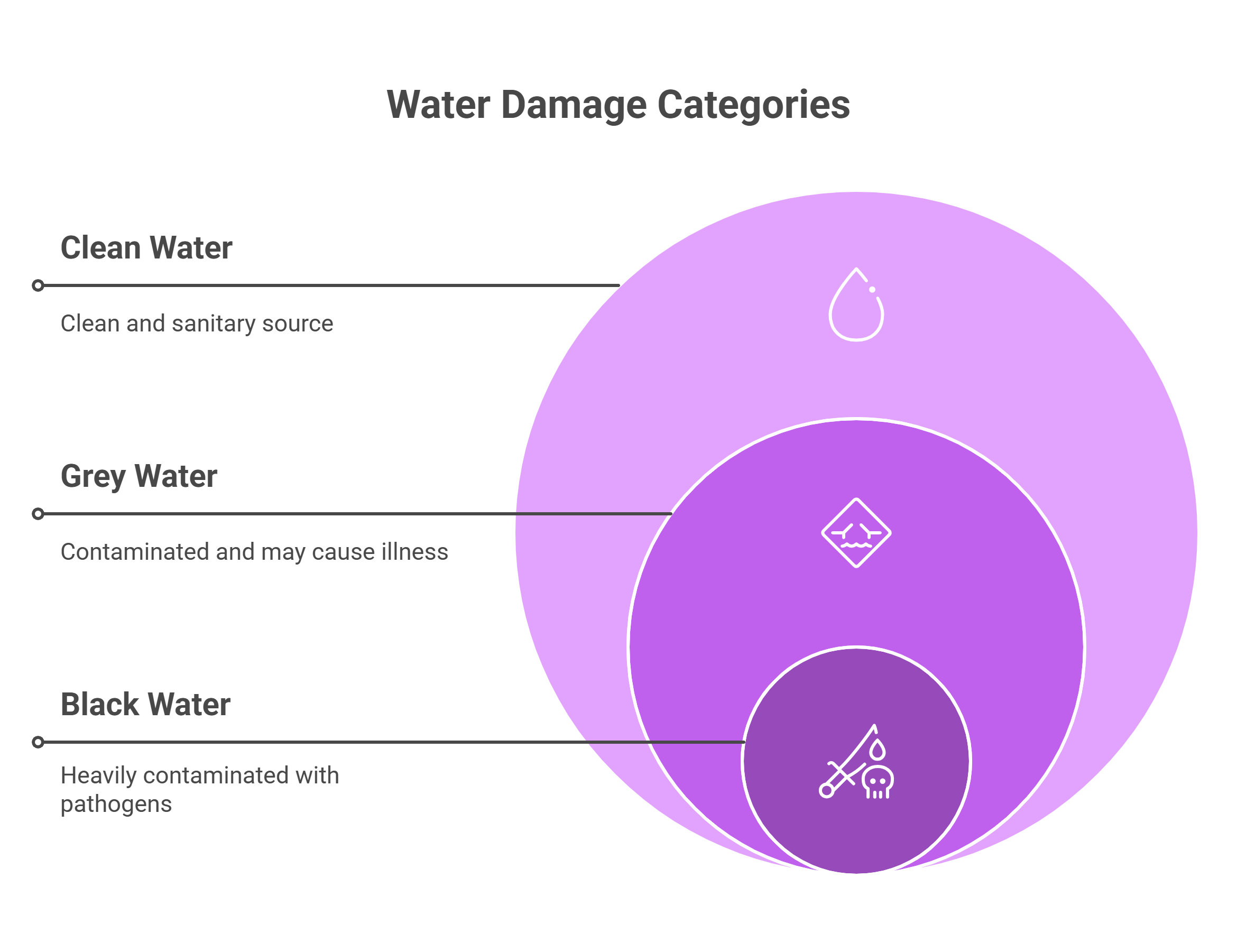One of the most common and costly problems that many property owners face is water damage, especially in regions like Vancouver, where weather and infrastructure can increase risk. That is why understanding types of water damage and recognizing the 4 classes of water damage along with their categories, is important for effective restoration, insurance claims, and long-term property health. In this article, we will investigate all the details about it.

The Importance of Identifying Types of Water Damage
Water damage can happen gradually or at once and harm buildings in both clear and unclear ways. Understanding the types of water damage, whether from a burst pipe, storm, or malfunctioning appliance, will help you respond appropriately, safeguard your health, and decrease expenses.
Categories of Water Damage
The IICRC (Institute of Inspection Cleaning and Restoration Certification) sets industry standards for classifying water damage. The categories of water damage are:
- Category 1 Water Damage: Clean Water
- Category 2 Water Damage: Grey Water
- Category 3 Water Damage: Black Water
The categories of water damage and class system are designed to assess both the source of water and the level of contamination, which directly impacts restoration methods and health risks. Here are details of each category:
Category 1 Water Damage: Clean Water
Category 1 water damage involves water that comes from a clean and sanitary source. This type of water does not pose any serious health risks. Common sources include broken supply lines, melting ice or snow, rainwater, and water from toilet tanks or bowls that do not contain contaminants. While the health risk is minimal at first, the situation can become more serious if the water is not cleaned up quickly, as it may become contaminated over time. Usually, materials like drywall, carpet, and wood can be dried and saved if you start cleaning up as fast as possible. For more detailed information about category 1 water damage, including steps for prevention and restoration, check out our comprehensive guide on water damage restoration.
Category 2 Water Damage: Grey Water
Category 2 water damage, or grey water, is contaminated water that can cause discomfort or illness if it comes in contact with the skin or is ingested. It can result from sources such as washing machines, dishwashers, toilet overflows with urine content, broken aquariums, or water beds. Grey water contains chemical, biological, or physical contaminants. Restoration usually involves the removal of affected materials, such as carpet padding, and full cleaning of the area.
For more detailed information about what is category 2 water damage, check out our comprehensive article on water damage restoration, where we discuss the causes, risks, and necessary steps for cleanup and prevention.
Category 3 Water Damage: Black Water
Category 3 water damage, or black water, is the most dangerous type. It is water that is heavily contaminated with poisonous pathogens, sewage, or toxic toxins. Common sources include sewer backups, river or sea water inundation, and storm surges. Black water is a health hazard because it contains viruses, bacteria, and other poisonous agents. Among the categories of water damage, this category needs immediate attention, and you should remove all contaminated materials and disinfect the area completely. Professional restoration services must be used to safely deal with this category of water damage.
What Are the Classes of Water Damage?
While categories focus on contamination, classes of water damage measure how much water is involved and how deeply it has entered building materials. Here are 4 classes of water damage:
- Class 1: Least amount of damage, quick drying.
- Class 2: Moderate amount of damage, widespread moisture.
- Class 3: The greatest amount of damage, Extensive saturation, needs urgent response.
- Class 4: Seep absorption, needs specialty drying situations.
Here are more details about each one:
- Class 1 water damage is the least severe and least serious class of water damage. It means only a small part of a room or area is wet, with minimal water absorption. Usually, materials like concrete or wood become wet with little moisture, so you should do the drying process quickly.
- Class 2 water damage involves a larger area, with water soaking into carpets, walls, and structural wood. In this class, about 5% to 40% of the combined floor, wall, and ceiling surfaces are affected. Porous materials like carpet and drywall are wet, but low-evaporation materials like wood have absorbed only a little water.
- Class 3 water damage is the most extensive one among all, with more than 40% of the room’s surfaces, such as floors, walls, and ceilings. You can see that everywhere is saturated by water. Water affects insulation, carpets, and walls. This class needs a fast and detailed drying process.
- Class 4 water damage is unique because it involves materials that absorb water very slowly, like hardwood, plaster, brick, or stone. In these cases, water has deeply penetrated the structure, and you will need specialized drying methods. These situations often take longer to resolve because the water is trapped within dense building materials.
Understanding the 4 classes of water damage helps professionals decide on the best restoration approach.
Risks Associated with Each Category and Class
Water category and class in the case of damages will cause some risks which are:
| Category | Details |
| Health Risks | • Category 1: Low risk, but increases if water sits and becomes contaminated. • Category 2: Moderate risk, with potential illness from contact or ingestion. • Category 3: High risk due to pathogens and toxins. Mold growth is almost certain if not treated. |
| Structural Risks | • Short-Term: Warping, staining, and swelling of materials. • Long-Term: Structural weakening, foundation damage, and potential collapse if water affects load-bearing components. |
| Mold Growth | Mold can start growing within 72 hours after water exposure, especially in hidden or unventilated areas. It poses both health hazards and leads to property damage. |
Insurance Coverage: What Types of Water Damage Are Covered?
Most standard homeowners’ insurance plans cover sudden water damage from things inside the home, like broken pipes or faulty appliances. But they usually don’t cover slow damage from poor maintenance or flooding from outside sources like rain or rivers. For those kinds of problems, you will need special insurance or add-ons. Here are some important points:
- Covered: Sudden leaks, burst pipes, accidental overflows.
- Not Covered: Flooding, sewer backups (unless you have specific coverage), gradual leaks, or damage from lack of maintenance.
Always check your policy details and consider additional coverage if you live in a flood-prone area.
Water Damage Class and Category: Why They Matter
Understanding water damage class and category is important because:
- Health Risks: Higher categories and classes increase the risk of mold, bacteria, and structural damage. You should know how to act to decrease the health risks of each one.
- Restoration Strategy: If you know the class and categories well, you will do urgency, and prepare the equipment and methods that you need for effective drying and cleaning.
- Insurance Coverage: Insurers use these classifications to assess claims and determine coverage. So be careful about recognizing each one with the best information.
Revive Restoration has helped many Vancouver residents recover from water damage, ranging from minor leaks to major floods. Our IICRC-certified team uses the latest technology and methods to restore homes and businesses efficiently and safely. If you do not know how to recognize categories and classes of water damage, ask us for help.
Professional Water Damage Restoration: Step-by-Step Process
Restoration companies like Revive Restoration in Vancouver follow industry practices that are set by the IICRC, to ensure safe and effective recovery. Here are its steps:
1. Emergency Response and Assessment
Water damage can’t wait, so restoration teams will respond quickly. Certified experts arrive quickly to evaluate the situation, determining how severe the damage is and identifying the specific category and classes of water damage.
2. Water Removal
The next step is to use strong industrial vacuums and pumps to remove any remaining water. This gets the area ready for complete drying and helps stop additional damage.
3. Drying and Dehumidification
TE restoration team uses specialized tools like air movers and dehumidifiers to dry out the impacted areas after the water has been removed. Advanced drying techniques are used to make sure everything is completely dry in more complicated situations, like when water has seeped into plaster walls or hardwood floors (Class 4).
4. Cleaning and Sanitizing
All impacted materials must be carefully removed in situations where the water is contaminated (Categories 2 and 3). After that, antimicrobial solutions are applied to the area to get rid of mold, bacteria, and other dangerous organisms.
5. Restoration and Repairs
Finally, damaged parts of the property, such as flooring, drywall, and structural elements are repaired or replaced. A complete final inspection ensures that the property is fully restored and safe to use, returning it to its original condition before the damage.
Why Choose Revive Restoration Company?
Revive Restoration, with its IICRC certification, offers certified expertise, sincere concern, and fast action in identifying water damage types and extents, ensuring industry standards are met. This company provides services like:
Water Damage Restoration in North Vancouver
In North Vancouver, quick action matters when water damage happens. Revive Restoration’s certified team, as one of the best water damage restoration companies in North Vancouver, responds fast, assesses the problem exactly, and restores your home with care and professionalism. Don’t wait—contact us today for reliable water damage restoration North Vancouver and protect your property from further harm.
Water Damage Restoration in West Vancouver
West Vancouver homes need expert care when facing water damage. That is why water damage restoration West Vancouver is so important. Revive Restoration offers fast and reliable service backed by industry certifications and a commitment to clear communication and lasting results. Contact us today to schedule your restoration and safeguard your home with trusted experts.
Revive Restoration Company: Best Partner for Water Damage Repair
When water damage strikes, you need a team that acts fast, knows what to do, and treats your home with care. That’s exactly what you get with Revive Restoration. From small leaks to major flooding, our certified experts handle it all with skill and expertise. Don’t wait, contact Revive today and get your home back to normal condition fast.
FAQs
- What are the different categories of water damage?
There are three: Category 1 (clean water), Category 2 (gray water), and Category 3 (black water). - How does Category 2 water damage differ from Category 3?
Category 2 may make you sick if you touch or swallow it, but Category 3 contains dangerous bacteria and toxins. - Is water damage covered by standard homeowners insurance?
Yes, but only for sudden and internal issues like pipe bursts, not floods or long-term leaks. - How quickly should I respond to water damage to prevent mold?
Within 24 to 48 hours, mold can start growing fast, especially in hidden or damp areas. - What steps are involved in professional water damage restoration?
They remove the water, dry everything, clean affected areas, and repair any damage.






